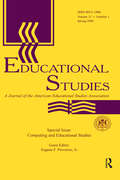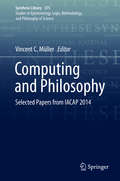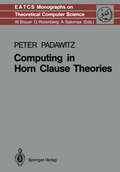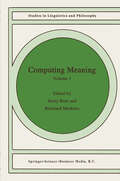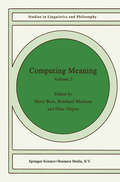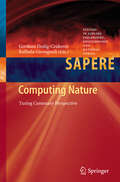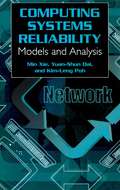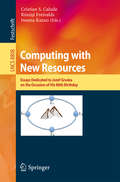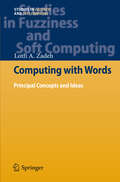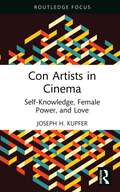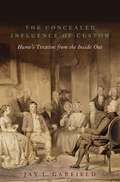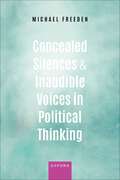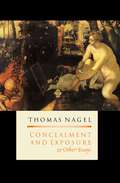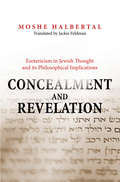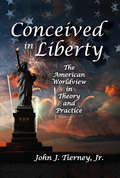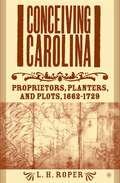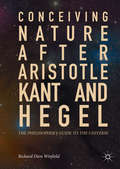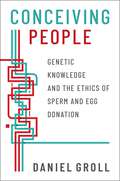- Table View
- List View
Computing and Educational Studies: A Special Issue of educational Studies
by Eugene F. ProvenzoThis special issue calls for a greater awareness of computing as a critical area of study for those interested in educational studies. Its purpose is to open up a wider dialogue about computing and education than has previously existed in the field. The questions raised provide the basis for a lively discussion and analysis of the role of educational studies in interpreting the role of computing in our culture and educational system. This issue also provides a model for exploring other topics of similar significance and importance to the field in future issues of the journal.
Computing and Educational Studies: A Special Issue of educational Studies (Counterpoints Ser. #123)
by Eugene F. Provenzo Jr.This special issue calls for a greater awareness of computing as a critical area of study for those interested in educational studies. Its purpose is to open up a wider dialogue about computing and education than has previously existed in the field. The questions raised provide the basis for a lively discussion and analysis of the role of educational studies in interpreting the role of computing in our culture and educational system. This issue also provides a model for exploring other topics of similar significance and importance to the field in future issues of the journal.
Computing and Philosophy: Selected Papers from IACAP 2014 (Synthese Library #375)
by Vincent C. MüllerThis volume offers very selected papers from the 2014 conference of the “International Association for Computing and Philosophy” (IACAP) - a conference tradition of 28 years. The theme of the papers is the two-way relation between computing technologies and philosophical questions: Computing technologies both raise new philosophical questions, and shed light on traditional philosophical problems. The chapters cover: 1) philosophy of computing, 2) philosophy of computer science & discovery, 3) philosophy of cognition & intelligence, 4) computing & society, and 5) ethics of computation.
Computing in Horn Clause Theories (Monographs in Theoretical Computer Science. An EATCS Series #16)
by Peter PadawitzAt least four research fields detennine the theoretical background of specification and deduction in computer science: recursion theory, automated theorem proving, abstract data types and tenn rewriting systems. As these areas approach each other more and more, the strong distinctions between functional and relational views, deductive and denotational approaches as well as between specification and programming are relieved in favour of their integration. The book will not expose the lines of this development; conversely, it starts out from the nucleus of Hom clause logic and brings forth both known and unknown results, most of which affect more than one of the fields mentioned above. Chapter 1 touches on historical issues of specification and prototyping and delimits the topics handled in this book from others which are at the core of related work. Chapter 2 provides the fundamental notions and notations needed for the presentation and interpretation of many-sorted Horn clause theories with equality. Chapter 3 supplies a number of sample Hom clause specifications ranging from arithmetic through string manipulation to higher data structures and interpreters of programming languages. Some of these examples serve as a reference to illustrate definitions and results, others may throw a light on the strong link between specifications and programs, which are executed by applying deduction rules. Thus we have included examples of how to use program trans/ormation methods in specification design.
Computing Meaning: Volume 1 (Studies in Linguistics and Philosophy #73)
by H. Bunt Reinhard MuskensThis book is a collection of papers written by outstanding researchers in the newly emerging field of computational semantics. It is aimed at those linguists, computer scientists, and logicians who want to know more about the algorithmic realization of meaning in natural language and about what is happening in this field of research. It includes a general introduction by the editors.
Computing Meaning: Volume 2 (Studies in Linguistics and Philosophy #77)
by Harry Bunt Reinhard Muskens Elias ThijsseThis book is a collection of papers written by outstanding researchers in the newly emerging field of computational semantics. Computational semantics is concerned with the computation of the meanings of linguistic objects such as text fragments, spoken dialogue utterances, and e-mail messages. The meaning of such an object is determined partly by linguistic information and partly by information from the context in which the object occurs. The information from these sources is combined by processes that infer which interpretation of the object applies in the given context. This applies not only to notoriously difficult aspects of interpreting linguistic objects, such as indexicals, anaphora, and metonymy, but also to establishing the precise reference of common nouns and the scopes of noun phrases. The central issue in computational semantics is how processes of finding and combining the relevant linguistic and contextual information into contextually appropriate meanings can be organised. Traditional approaches of applying context information to disambiguated natural language expressions do not work well, due to the massive ambiguity in natural language. Recent work in computational semantics suggests, alternatively, to represent linguistic semantic information in formal structures with underspecification, and to apply context information in inference processes that result in further specification of these representations. Underspecified representation and inference are therefore the key topics in this book. The book is aimed at those linguists, computer scientists, and logicians who take an interest in the computation of meaning, and who want to know what is happening in this exciting field of research.
Computing Nature: Turing Centenary Perspective (Studies in Applied Philosophy, Epistemology and Rational Ethics #7)
by Gordana Dodig-Crnkovic Raffaela GiovagnoliThis book is about nature considered as the totality of physical existence, the universe, and our present day attempts to understand it. If we see the universe as a network of networks of computational processes at many different levels of organization, what can we learn about physics, biology, cognition, social systems, and ecology expressed through interacting networks of elementary particles, atoms, molecules, cells, (and especially neurons when it comes to understanding of cognition and intelligence), organs, organisms and their ecologies? Regarding our computational models of natural phenomena Feynman famously wondered: “Why should it take an infinite amount of logic to figure out what one tiny piece of space/time is going to do?” Phenomena themselves occur so quickly and automatically in nature. Can we learn how to harness nature’s computational power as we harness its energy and materials? This volume includes a selection of contributions from the Symposium on Natural Computing/Unconventional Computing and Its Philosophical Significance, organized during the AISB/IACAP World Congress 2012, held in Birmingham, UK, on July 2-6, on the occasion of the centenary of Alan Turing’s birth. In this book, leading researchers investigated questions of computing nature by exploring various facets of computation as we find it in nature: relationships between different levels of computation, cognition with learning and intelligence, mathematical background, relationships to classical Turing computation and Turing’s ideas about computing nature - unorganized machines and morphogenesis. It addresses questions of information, representation and computation, interaction as communication, concurrency and agent models; in short this book presents natural computing and unconventional computing as extension of the idea of computation as symbol manipulation.
Computing System Reliability: Models and Analysis
by Min Xie Kim-Leng Poh Yuan-Shun DaiComputing systems are of growing importance because of their wide use in many areas including those in safety-critical systems. This book describes the basic models and approaches to the reliability analysis of such systems. An extensive review is provided and models are categorized into different types. Some Markov models are extended to the analysis of some specific computing systems such as combined software and hardware, imperfect debugging processes, failure correlation, multi-state systems, heterogeneous subsystems, etc. One of the aims of the presentation is that based on the sound analysis and simplicity of the approaches, the use of Markov models can be better implemented in the computing system reliability.
Computing with New Resources: Essays Dedicated to Jozef Gruska on the Occasion of His 80th Birthday (Lecture Notes in Computer Science #8808)
by Cristian S. Calude Rusins Freivalds Iwama KazuoProfessor Jozef Gruska is a well known computer scientist for his many and broad results. He was the father of theoretical computer science research in Czechoslovakia and among the first Slovak programmers in the early 1960s. Jozef Gruska introduced the descriptional complexity of grammars, automata, and languages, and is one of the pioneers of parallel (systolic) automata. His other main research interests include parallel systems and automata, as well as quantum information processing, transmission, and cryptography. He is co-founder of four regular series of conferences in informatics and two in quantum information processing and the Founding Chair (1989-96) of the IFIP Specialist Group on Foundations of Computer Science.
Computing with Words: Principal Concepts and Ideas (Studies in Fuzziness and Soft Computing #277)
by Lotfi A. ZadehIn essence, Computing with Words (CWW) is a system of computation in which the objects of computation are predominantly words, phrases and propositions drawn from a natural language. CWW is based on fuzzy logic. In science there is a deep-seated tradition of according much more respect to numbers than to words. In a fundamental way, CWW is a challenge to this tradition. What is not widely recognized is that, today, words are used in place of numbers in a wide variety of applications ranging from digital cameras and household appliances to fraud detection systems, biomedical instrumentation and subway trains. CWW offers a unique capability—the capability to precisiate natural language. Unprecisiated (raw) natural language cannot be computed with. A key concept which underlies precisiation of meaning is that of the meaning postulate: A proposition, p, is a restriction on the values which a variable, X—a variable which is implicit in p—is allowed to take. CWW has an important ramification for mathematics. Addition of the formalism of CWW to mathematics empowers mathematics to construct mathematical solutions of computational problems which are stated in a natural language. Traditional mathematics does not have this capability.
Con Artists in Cinema: Self-Knowledge, Female Power, and Love (Routledge Focus on Film Studies)
by Joseph H. KupferThis book examines the con artist film as a genre, exploring its main features while also addressing variations within it. The volume explores three diverse themes of the con artist film: edification, self-awareness, and liberation through con games; the femme fatale as con artist; and romantic love as a plot point. Analyzing movies such as Matchstick Men (2003), House of Games (1987), Body Heat (1981), The Last Seduction (1994), Birthday Girl (2001), and The Game (1997), the book also explores their psychological investigation of the con artist figure, the con artist’s mark, and how the dynamic between these roles implicates us as the audience. It also addresses the con artist film genre’s close association with neo-noir, especially through the femme fatale figure, investigating and updating the rich tradition of noir film. Demonstrating the range and flexibility of this understudied genre, this book will be of interest to scholars and students of film studies, ethics, and those studying the representation of women in film..
Con Artists in Cinema: Self-Knowledge, Female Power, and Love (Routledge Focus on Film Studies)
by Joseph H. KupferThis book examines the con artist film as a genre, exploring its main features while also addressing variations within it. The volume explores three diverse themes of the con artist film: edification, self-awareness, and liberation through con games; the femme fatale as con artist; and romantic love as a plot point. Analyzing movies such as Matchstick Men (2003), House of Games (1987), Body Heat (1981), The Last Seduction (1994), Birthday Girl (2001), and The Game (1997), the book also explores their psychological investigation of the con artist figure, the con artist’s mark, and how the dynamic between these roles implicates us as the audience. It also addresses the con artist film genre’s close association with neo-noir, especially through the femme fatale figure, investigating and updating the rich tradition of noir film. Demonstrating the range and flexibility of this understudied genre, this book will be of interest to scholars and students of film studies, ethics, and those studying the representation of women in film..
The Concealed Influence of Custom: Hume's Treatise from the Inside Out
by Jay L. GarfieldJay L. Garfield defends two exegetical theses regarding Hume's Treatise on Human Nature. The first is that Book II is the theoretical foundation of the Treatise. Second, Garfield argues that we cannot understand Hume's project without an appreciation of his own understanding of custom, and in particular, without an appreciation of the grounding of his thought about custom in the legal theory and debates of his time. Custom is the source of Hume's thoughts about normativity, not only in ethics and in political theory, but also in epistemological, linguistics, and scientific practice- and is the source of his insight that our psychological and social natures are so inextricably linked. The centrality of custom and the link between the psychological and the social are closely connected, which is why Garfield begins with Book II. There are four interpretative perspectives at work in this volume: one is a naturalistic skeptical interpretation of Hume's Treatise; a second is the foregrounding of Book II of the Treatise as foundational for Books I and III. A third is the consideration of the Treatise in relation to Hume's philosophical antecedents (particularly Sextus, Bayle, Hutcheson, Shaftesbury, and Mandeville), as well as eighteenth century debates about the status of customary law, with one eye on its sequellae in the work of Kant, the later Wittgenstein, and in contemporary cognitive science. The fourth is the Buddhist tradition in which many of the ideas Hume develops are anticipated and articulated in somewhat different ways. Garfield presents Hume as a naturalist, a skeptic and as, above all, a communitarian. In offering this interpretation, he provides an understanding of the text as a whole in the context of the literature to which it responded, and in the context of the literature it inspired.
CONCEALED INFLUENCE OF CUSTOM C: Hume's Treatise from the Inside Out
by Jay L. GarfieldJay L. Garfield defends two exegetical theses regarding Hume's Treatise on Human Nature. The first is that Book II is the theoretical foundation of the Treatise. Second, Garfield argues that we cannot understand Hume's project without an appreciation of his own understanding of custom, and in particular, without an appreciation of the grounding of his thought about custom in the legal theory and debates of his time. Custom is the source of Hume's thoughts about normativity, not only in ethics and in political theory, but also in epistemological, linguistics, and scientific practice- and is the source of his insight that our psychological and social natures are so inextricably linked. The centrality of custom and the link between the psychological and the social are closely connected, which is why Garfield begins with Book II. There are four interpretative perspectives at work in this volume: one is a naturalistic skeptical interpretation of Hume's Treatise; a second is the foregrounding of Book II of the Treatise as foundational for Books I and III. A third is the consideration of the Treatise in relation to Hume's philosophical antecedents (particularly Sextus, Bayle, Hutcheson, Shaftesbury, and Mandeville), as well as eighteenth century debates about the status of customary law, with one eye on its sequellae in the work of Kant, the later Wittgenstein, and in contemporary cognitive science. The fourth is the Buddhist tradition in which many of the ideas Hume develops are anticipated and articulated in somewhat different ways. Garfield presents Hume as a naturalist, a skeptic and as, above all, a communitarian. In offering this interpretation, he provides an understanding of the text as a whole in the context of the literature to which it responded, and in the context of the literature it inspired.
Concealed Silences and Inaudible Voices in Political Thinking
by Michael FreedenConcealed Silences and Inaudible Voices in Political Thinking investigates silence as a normal, ubiquitous, and indispensable element of political thinking, theory, and language. It explores the diverse dimensions in which silences mould the different core features of the political, as a highly flexible power resource, both enabling and constraining major social practices, traditions, and currents. Departing from the typical focus on intentional silencing and the dominance of logos, the book instead highlights the concealed and unrecognized ways through which silence pervades socio-political life and adopts the guises of the unspeakable, the ineffable, the inarticulable, and the unconceptualizable. Drawing extensively from historical, philosophical, anthropological, psychoanalytical, theological, linguistic, and literary viewpoints, the book demonstrates the common threads that connect silences to those different disciplines, alongside the features that pull them asunder. In extracting and decoding their political implications, it explores both academic literature and colloquial, everyday discourse. Michael Freeden uses select case-studies to explore topics such as Buddhist nondualism, Locke's tacit consent, the submerging of historical narratives, state neutrality, Pinter's miscommunications and menace, and the separate ways ideologies integrate silence into their beliefs. The book offers an analysis of silence from a multi-perspectival range of disciplines, providing a comprehensive and holistic view of silence and the political.
Concealed Silences and Inaudible Voices in Political Thinking
by Michael FreedenConcealed Silences and Inaudible Voices in Political Thinking investigates silence as a normal, ubiquitous, and indispensable element of political thinking, theory, and language. It explores the diverse dimensions in which silences mould the different core features of the political, as a highly flexible power resource, both enabling and constraining major social practices, traditions, and currents. Departing from the typical focus on intentional silencing and the dominance of logos, the book instead highlights the concealed and unrecognized ways through which silence pervades socio-political life and adopts the guises of the unspeakable, the ineffable, the inarticulable, and the unconceptualizable. Drawing extensively from historical, philosophical, anthropological, psychoanalytical, theological, linguistic, and literary viewpoints, the book demonstrates the common threads that connect silences to those different disciplines, alongside the features that pull them asunder. In extracting and decoding their political implications, it explores both academic literature and colloquial, everyday discourse. Michael Freeden uses select case-studies to explore topics such as Buddhist nondualism, Locke's tacit consent, the submerging of historical narratives, state neutrality, Pinter's miscommunications and menace, and the separate ways ideologies integrate silence into their beliefs. The book offers an analysis of silence from a multi-perspectival range of disciplines, providing a comprehensive and holistic view of silence and the political.
Concealment and Exposure: And Other Essays
by Thomas NagelThomas Nagel is widely recognized as one of the top American philosophers working today. Reflecting the diversity of his many philosophical preoccupations, this volume is a collection of his most recent critical essays and reviews. The first section, Public and Private, focuses on the notion of privacy in the context of social and political issues, such as the impeachment of President Clinton. The second section, Right and Wrong, discusses moral, political and legal theory, and includes pieces on John Rawls, G.A. Cohen, and T.M. Scanlon, among others. The final section, Mind and Reality, features discussions of Richard Rorty, Donald Davidson, and the Sokal hoax, and closes with a substantial new essay on the mind-body problem. Written with characteristic rigor, these pieces reveal the intellectual passion underlying the incisive analysis for which Nagel is known.
Concealment and Revelation: Esotericism in Jewish Thought and its Philosophical Implications
by Moshe Halbertal Jackie FeldmanDuring the twelfth and thirteenth centuries, great new trends of Jewish thought emerged whose widely varied representatives--Kabbalists, philosophers, and astrologers--each claimed that their particular understanding revealed the actual secret of the Torah. They presented their own readings in a coded fashion that has come to be regarded by many as the very essence of esotericism. Concealment and Revelation takes us on a fascinating journey to the depths of the esoteric imagination. Carefully tracing the rise of esotericism and its function in medieval Jewish thought, Moshe Halbertal's richly detailed historical and cultural analysis gradually builds conceptual-philosophical force to culminate in a masterful phenomenological taxonomy of esotericism and its paradoxes. Among the questions addressed: What are the internal justifications that esoteric traditions provide for their own existence, especially in the Jewish world, in which the spread of knowledge was of great importance? How do esoteric teachings coexist with the revealed tradition, and what is the relationship between the various esoteric teachings that compete with that revealed tradition? Halbertal concludes that, through the medium of the concealed, Jewish thinkers integrated into the heart of the Jewish tradition diverse cultural influences such as Aristotelianism, Neoplatonism, and Hermeticisims. And the creation of an added concealed layer, unregulated and open-ended, became the source of the most daring and radical interpretations of the tradition.
Concealment and Revelation: Esotericism in Jewish Thought and its Philosophical Implications (PDF)
by Moshe Halbertal Jackie FeldmanDuring the twelfth and thirteenth centuries, great new trends of Jewish thought emerged whose widely varied representatives--Kabbalists, philosophers, and astrologers--each claimed that their particular understanding revealed the actual secret of the Torah. They presented their own readings in a coded fashion that has come to be regarded by many as the very essence of esotericism. Concealment and Revelation takes us on a fascinating journey to the depths of the esoteric imagination. Carefully tracing the rise of esotericism and its function in medieval Jewish thought, Moshe Halbertal's richly detailed historical and cultural analysis gradually builds conceptual-philosophical force to culminate in a masterful phenomenological taxonomy of esotericism and its paradoxes. Among the questions addressed: What are the internal justifications that esoteric traditions provide for their own existence, especially in the Jewish world, in which the spread of knowledge was of great importance? How do esoteric teachings coexist with the revealed tradition, and what is the relationship between the various esoteric teachings that compete with that revealed tradition? Halbertal concludes that, through the medium of the concealed, Jewish thinkers integrated into the heart of the Jewish tradition diverse cultural influences such as Aristotelianism, Neoplatonism, and Hermeticisims. And the creation of an added concealed layer, unregulated and open-ended, became the source of the most daring and radical interpretations of the tradition.
Conceived in Liberty: The American Worldview in Theory and Practice
by Jr. TierneyConceived in Liberty is a cultural, sociological and geopolitical review of the uniquely American notion that the country and its people are "exceptional." While all nations have their own patriotic commitments, no other people have outwardly declared their power as vigorously as have Americans, especially since World War II.John J. Tierney, Jr. advances the idea that liberty is the singular source of the power of the American worldview and all other elements of this society equality, patience, charity, justice, etc.are derived from liberty. He argues that this worldview comes from this one source and is responsible for the many movements that may engage the public's interest, such as women's rights, civil rights, and voting rights. Such movements are all positive, but they could not exist in a society devoid of liberty.Conceived in Liberty also traces other main components of the American worldview: geographic expanse, immigration, energy of the populace, diversity, public policies, and the elements that contribute to exceptionalism. Tierney is not blind to some of the deficiencies of the United States, but he posits that the liberty it manifests is truly the political globe's last, best hope.
Conceived in Liberty: The American Worldview in Theory and Practice (Conceived In Liberty Ser. #Vol. 5)
by Jr. TierneyConceived in Liberty is a cultural, sociological and geopolitical review of the uniquely American notion that the country and its people are "exceptional." While all nations have their own patriotic commitments, no other people have outwardly declared their power as vigorously as have Americans, especially since World War II.John J. Tierney, Jr. advances the idea that liberty is the singular source of the power of the American worldview and all other elements of this society equality, patience, charity, justice, etc.are derived from liberty. He argues that this worldview comes from this one source and is responsible for the many movements that may engage the public's interest, such as women's rights, civil rights, and voting rights. Such movements are all positive, but they could not exist in a society devoid of liberty.Conceived in Liberty also traces other main components of the American worldview: geographic expanse, immigration, energy of the populace, diversity, public policies, and the elements that contribute to exceptionalism. Tierney is not blind to some of the deficiencies of the United States, but he posits that the liberty it manifests is truly the political globe's last, best hope.
Conceiving Carolina: Proprietors, Planters, and Plots, 1662–1729
by L. RoperWritten from a transatlantic perspective and based largely on primary sources, Conceiving Carolina provides the first systematic treatment of the colonization of South Carolina in over a century. It argues that the political culture that developed in the colony amounted to an extension of the political life in early modern England. Provincial politics, in turn, shaped social developments, notably the emergence of a slave society. Thus, the book calls into question the notion of the inherent distinction and modernity of colonial British America.
Conceiving Nature after Aristotle, Kant, and Hegel: The Philosopher's Guide to the Universe
by Richard Dien WinfieldThis book defies the reigning dismissal of the philosophy of nature by turning to what Aristotle, Kant, and Hegel have had to say about nature and critically thinking through their arguments to reconstruct a comprehensive account of the universe. Aided by the contributions of more recent thinkers, such as Albert Einstein, Werner Heisenberg, Michael B. Foster, and Hans Jonas, Conceiving Nature shows how the mechanics of matter in motion, the physics of electromagnetism, and chemical process provide all that is needed for life to emerge and give rise to rational animals capable of knowing nature in truth. The work contains detailed discussions of much of Aristotle’s writing on nature, of Kant’s Metaphysical Foundations of Natural Science, and of Hegel’s Philosophy of Nature.
Conceiving Nature after Aristotle, Kant, and Hegel: The Philosopher's Guide to the Universe
by Richard Dien WinfieldThis book defies the reigning dismissal of the philosophy of nature by turning to what Aristotle, Kant, and Hegel have had to say about nature and critically thinking through their arguments to reconstruct a comprehensive account of the universe. Aided by the contributions of more recent thinkers, such as Albert Einstein, Werner Heisenberg, Michael B. Foster, and Hans Jonas, Conceiving Nature shows how the mechanics of matter in motion, the physics of electromagnetism, and chemical process provide all that is needed for life to emerge and give rise to rational animals capable of knowing nature in truth. The work contains detailed discussions of much of Aristotle’s writing on nature, of Kant’s Metaphysical Foundations of Natural Science, and of Hegel’s Philosophy of Nature.
Conceiving People: Genetic Knowledge and the Ethics of Sperm and Egg Donation
by Daniel GrollEach year, tens of thousands of children are conceived with donated gametes (sperm or eggs). By some estimates, there are over one million donor-conceived people in the United States and, of course, many more the world over. Some know they are donor-conceived. Some do not. Some know the identity of their donors. Others never will. Questions about what donor-conceived people should know about their genetic progenitors are hugely significant for literally millions of people, including donor-conceived people, their parents, and donors. But the practice of gamete donation also provides a vivid occasion for thinking about questions that matter to everyone. What is the value of knowing who your genetic progenitors are? How are our identities bound up with knowing where we come from? What obligations do parents have to their children? And what makes someone a parent in the first place? In Conceiving People: Identity, Genetics and Gamete Donation, Daniel Groll argues that people who plan to create a child with donated gametes should choose a donor whose identity will be made available to the resulting child. This is not, Groll argues, because having genetic knowledge is fundamentally important. Rather, it is because donor-conceived people are likely to develop a significant interest in having genetic knowledge and parents must help satisfy their children's significant interests. In other words, because a donor-conceived person is likely to care about having genetic knowledge, their parents should care too.
